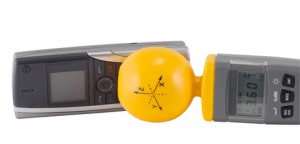The Buzz on EMFs

Last week I posted about cell phone radiation, and one of you asked – “should I be worried about electromagnetic fields in general?” In short, yes. But this, my friends, falls into the category of things I think we might need to live with and watch, because short of moving to the boonies and disconnecting ourselves from much of the technology on which we’ve come to rely, there isn’t any great way of completely avoiding EMFs. Read on and decide how hypochondriacal and OCD you’re willing to get over this one . . . .
So what exactly are electromagnetic fields, anyway? Everyone, every day, is exposed to a complex mix of weak electric and magnetic fields – they’re created whenever electricity flows through a conductor. These fields exist near power lines, in the wiring in your home, and near and in any electrical appliance or device. EMF exposure has been rumored to cause brain tumors, leukemia, birth defects, miscarriages, chronic fatigue, headaches, cataracts, heart problems, stress, nausea, chest pain, forgetfulness, cancer and a host of other health problems.
Numerous studies have produced contradictory results, but some experts are convinced the threat is real. For instance, Dr. David Carpenter, Dean at the School of Public Health, State University of New York believes it is likely that up to 30% of all childhood cancers come from exposure to EMFs. The U.S. EPA warns that “There is reason for concern” and advises “prudent avoidance.” Martin Halper, the EPA’s Director of Analysis and Support says “I have never seen a set of epidemiological studies that remotely approached the weight of evidence that we’re seeing with EMFs. Clearly there is something here.”
Magnetic fields are measured in milligauss (mG), and your exposure to them increases with your proximity to their source. The EPA safety standard for EMF exposure is rated at no more than 1 mG. According to the EPA, anything that emits an EMF higher than that is considered potentially unsafe. This, however, is also a point of debate. Some organizations rate the safe limit no higher than 0.5 mG, while others believe that anything under 3 mG is safe. How easy is it to be exposed at over 1 mG? Pretty darn easy, but remember, the longer you’re exposed, the worse it is. If you’re standing 4 feet from your microwave while it’s on, you’re getting between 3 and 8 milligauss. At 12 inches, it’s up to 80. And if you’re standing only 1.2 inches from your microwave (which, if you’re me, is entirely possible since it’s mounted above my cook-top), it’s nuking you with up to 2,000 milligauss. For comparison’s sake, here are the 1.2 inch exposures of other household appliances: washing machine: 400; electric range: 2,000; T.V.: 500; and hair dryer: up to 20,000. Perhaps there’s reason to consider a wash ‘n’ wear ‘do? Seriously, though – while you’re probably not standing in close range of your microwave or hairdryer for long periods of time, the worry lately is about our cumulative exposure to EMFs – their sources have proliferated at an alarming rate over the last 10 years, such that it’s nearly impossible not to be exposed via multiple sources every day.
So, by now you’re starting to freak out, right? You want to know – how the heck can I reduce my EMF exposure? The simplest way to limit your exposure to high EMF levels is to practice energy conservation techniques, such as unplugging electrical appliances that are not in use. And remember, your exposure increases as you spend more time in the EMF – so sleeping near appliances isn’t recommended. Here is a laundry-list of ideas of ways to reduce your exposure that I’ve collected from various sources.
- Use a wired network instead of a Wi-Fi or wireless network.
- Try to arrange your appliances, TVs and computers against outside walls so the electromagnetic field they produce doesn’t bleed into an adjoining room.
- Use wired speakers and other electronic components instead of wireless.
- When considering an alarm system for your home, opt for a wired system instead of a wireless system.
- When using the computer, try not to hold onto the mouse and learn keyboard strokes to replace mouse functions.
- Try to locate the computer tower, printer and wiring away from where you sit.
- Opt for LCD Flat Screen computer monitors.
- Avoid placing a laptop computer on your lap when you are using it.
- Store your cell phone in a case or backpack or purse where it won’t be right next to your body. When sleeping, keep your mobile phone at least 5 feet away from your bed.
- Place your electric alarm clock at least 5 feet away from your bed.
- Electric appliances and devices are surrounded by electric fields even when not turned on, so unplug these at night if they are in close proximity to your bed.
- Instead of fluorescent bulbs, use incandescent or full spectrum bulbs.
- As we discussed last week, if you use a cell phone, use the speakerphone when possible. Don’t use a Bluetooth headset that sits right against your skull – opt for a wired hands-free device.
- Avoid using waterbeds that need electric heaters.
- Find alternatives to electric blankets.
- Substitute a hot water bottle for a heating pad.
- Washing machines, clothes dryers, and dishwashers have large EMFs, especially when high efficiency. If someone is sleeping with the head of the bed on the wall behind these machines, don’t operate the machine when s/he is sleeping.
- The larger the television screen, the stronger and larger the EMF. So sit far back when viewing and again, don’t operate it if someone is sleeping directly behind the television wall.
- When using appliances, try to stand 2 to 3 feet back. For instance, when cooking on an electric stove (use back burners more often) or using your microwave.
- Remember that children are more susceptible to EMFs than adults. A one-year-old child can absorb almost twice as much radiation per kilo as an adult. Try to teach EMF-minimizing practices to your children while they are young so that it becomes part of their lifestyle.
- Don’t use a cell phone or cordless phone while holding a child.
- Limit the time your children spend in front of the television, computer or Playstation – remember, the amount of your exposure depends on the time you spend in the field. When your kids do these activities, get them to take regular breaks.
- Place your baby monitor away from the crib if you can: most baby monitors use digital wireless technology and the EMFs that they produce can be more powerful than living near a cell phone tower.
Want to geek-out and test the EMFs around your home? You’ll need an EMF detector, otherwise known as a Gauss meter. Gauss meters vary widely in price and accuracy. Meters have either a single axis coil or a triple axis coil. Single axis meters are much simpler to manufacture than triple axis meters and are less expensive. To use a single axis meter you must point the meter’s one sensor in each of three directions – the x-, y- and z-axis. Then, you combine the three readings using a mathematical equation to calculate the combined field strength. It’s far easier and more accurate to use a 3-axis meter. Triple axis Gauss meters are quite accurate, but they are also more expensive. Another thing to watch out for when purchasing a Gauss meter is whether or not it is “frequency weighted.” Most meters will read the same EMF strength no mater what the frequency. Because the human body appears to be sensitive to both the field strength and the frequency, Gauss meters used for biological purposes should be “frequency weighted.”
What’s my takeaway from all this? As with anything, I’ll take steps to do what I can to minimize our exposure to EMFs. I might get L. a battery-powered alarm clock (D. and I have these already – we just use our travel alarm clocks). I’ll take better care not to stand in front of the microwave. I won’t work with my laptop on my lap anymore. But am I giving up my hair-dryer? Heck no. Will I get rid of our at-home wireless network? Most likely not. Am I going to move to the middle of Montana and live in a refurbished Airstream trailer? Give up my beloved iPhone? I’d rather shoot myself. Remember, above all, it’s important to balance healthy habits with quality of life considerations.
Share with the group! Let us know what, if anything, you’re going to do about your EMF exposure.
© 2009 – 2010, Sarah. All rights reserved.
-
http://johntyselectric.com johnty
-
Kristy
-
River
-
Nicole
-
Nicole










